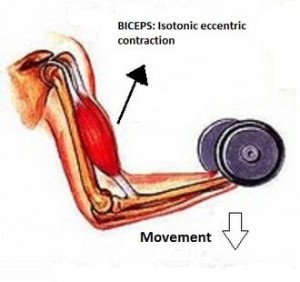Isometric vs concentric vs eccentric strength training- what is the difference?
The importance of avoiding sustained postures
July 6, 2015Mark Kincaid’s chat with Nicolette Griffioen
April 12, 2016People may have heard these three terms being used during training, but what do they actually mean, and what are the implications of these different types of contractions?
When it comes to strength/ resistance training, most people understand the general principle behind how muscles become stronger from a concentric point of view. For example, let’s look at a bicep curl movement with a weight. When you bend your elbow, the bicep will flex and contract and shorten with the weight in hand. This is what we know as a concentric contraction. During a concentric contraction, muscle fibres will contract and shorten under a load while moving through a particular range. This will result in strengthening of the bicep muscle. This is the kind of movement you see a lot at the gym.
Now what is an isometric contraction? Well, think about the bicep curl. If you bend your elbow, say half way and hold the position statically, the bicep muscle is contracting without actually doing any movement. This is very similar to a plank position where a person performs a contraction of their core without their body doing any movement. Generally isometric contractions are used earlier on in the rehabilitative process where you want to contract a muscle without actually moving a joint. Orthopaedic doctors like this type of strengthening after operations where they want some strengthening done but don’t want any movement of the operated joint. There is a school of thought however that the downside of isometric strengthening (especially later on in the rehab process) is that this type of training isn’t really functional. We have muscles and joints that move in various planes/ directions on a daily basis, but we hardly ever have to sustain static positions. If we look again at the plank example… even though it is a very popular exercise, is it really that functional?
Now let’s get to the eccentric contraction, which from an exercise/ rehabilitative point of view is probably the most interesting. Referring back to our bicep curl example, when the person has now bent their elbow and flexed the bicep with the weight in hand, the reverse movement now needs to be done and elbow returned back to its starting position. When I see a lot of people at the gym doing this part of the bicep curl, the arm is often just dropped back down to the side with minimal control. This is where the eccentric part of the contraction comes in.
The definition of eccentric loading is contraction but lengthening of a muscle. So what should happen when lowering the arm back down? It should be done in a slow controlled/ decelerated way, thus maintaining contraction of the bicep while it lengthens/ stretches. From an exertional point of view, eccentric contractions are more strenuous and take more effort compared to concentric contractions. This is because fewer muscle units are recruited when contracted eccentrically, therefore they have to work a lot harder. A good example of this is a long distance marathon. If we look at the Comrades marathon, a lot of runners will say that a downhill run is harder than an uphill run. When I first heard that, I was a bit confused as I thought it would be easier to run down a hill than up a hill. But learning what I know now, looking at concentric vs eccentric contractions, muscles in the legs work more concentrically with an uphill run, as the runner has to shorten and contract the leg muscles to accelerate/ propel themselves up the hill. When running down a hill the leg muscles have to continuously contract but in a lengthening/ decelerated manner, which is a lot more difficult. After a prolonged distance of downhill running, as muscles fatigue there is more impact/ loading on the knee and kneecap (patella). This can lead to injuries to the patellofemoral joint and Iliotibilal band (ITB) in particular.
So in summary with regards to isometric, concentric and eccentric exercises:
- Isometric exercises are generally used early on in the rehabilitation process as they are generally the least demanding
- Concentric exercises involve contraction and shortening of muscle fibres
- Eccentric exercises involve contraction and lengthening of muscles fibres and are the most physically demanding. It is crucial to include eccentric training into gym/ rehab programs as sufficient strength will reduce loading/ impact of joints. Eccentric strengthening is also a crucial component to rehabilitating tendon injuries

